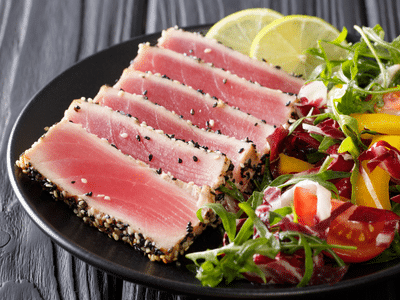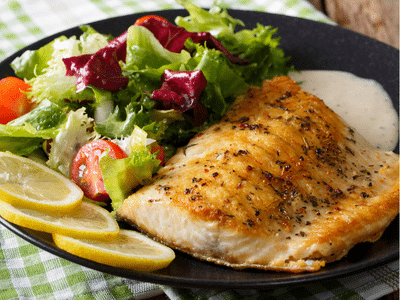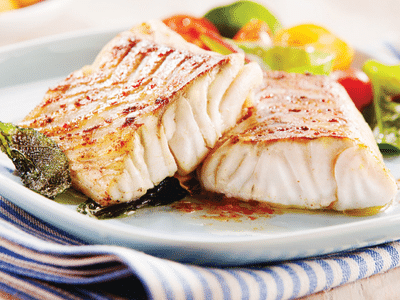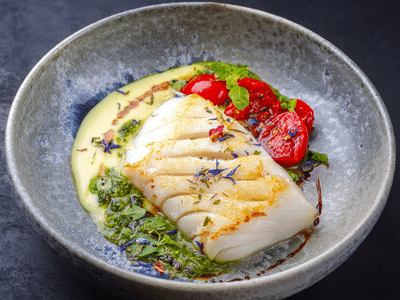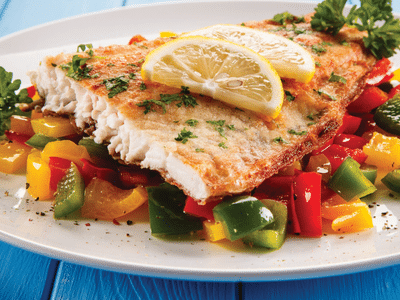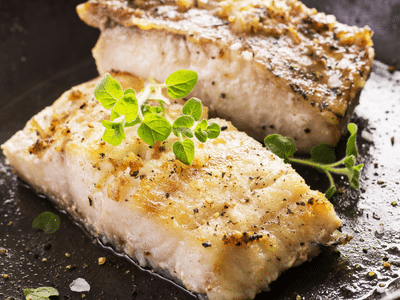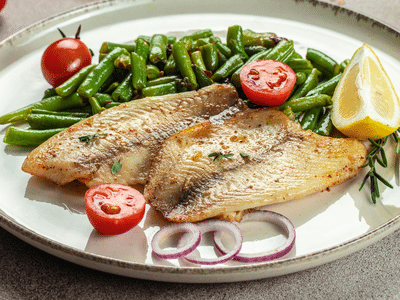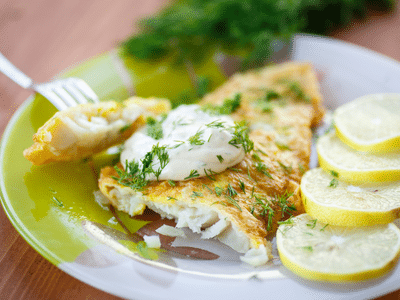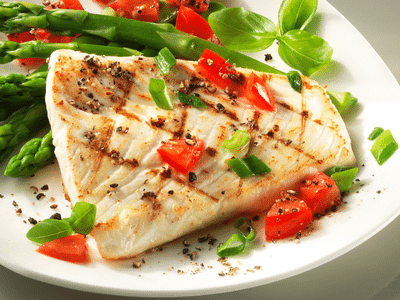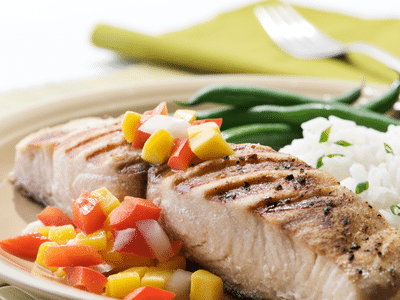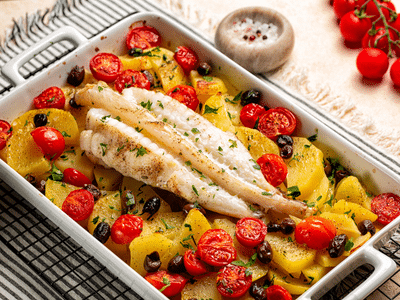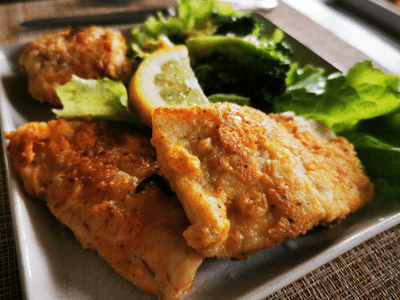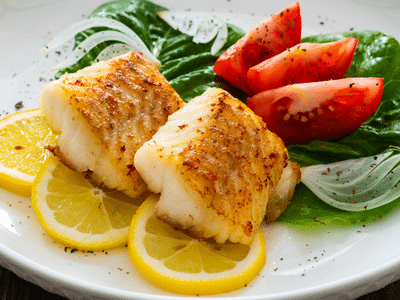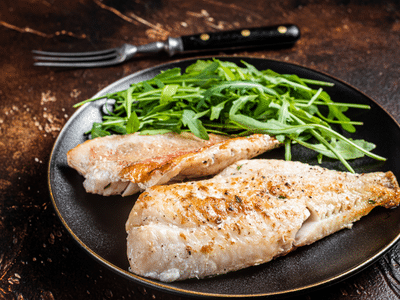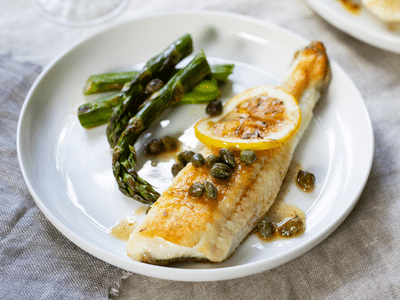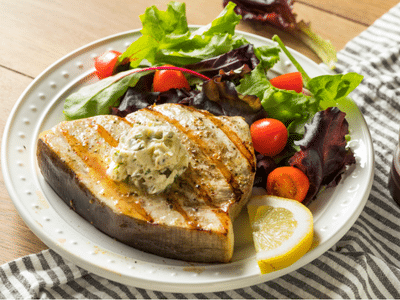
Festival Foods is proud to offer Fresh Flight Fish – 100% sustainable seafood that goes from shore to store within 72 hours. Our selection changes weekly based on availability and custom orders are welcome by visiting our Meat & Seafood counter to pre-order your favorites. To learn more about the varieties we offer, click on an option below.
Origin: Panama, Suriname and Trinidad
Taste & Texture: Firm texture with a mild taste. Similar to salmon and albacore tuna.
Cooking Methods:
- Searing ahi tuna in a skillet is a top choice as it crisps the outside while keeping the center rare. Heat a skillet with butter, olive oil and crushed peppercorns, then sear the steaks for 30 seconds to 1 1/2 minutes per side, depending on your desired doneness.
- Season the tuna and place it on a preheated grill over high heat. Cook for about two minutes per side, just enough to char the surface while the inside stays rare.
- Preheat the oven to 450°. Bake the seasoned steaks for eight to ten minutes. Flipping them halfway through is optional, but can help with even cooking.
- Set the air fryer to 380°. Cook the seasoned ahi tuna for four minutes for a quick and easy prep.
Seasonings: Rosemary, dill, tarragon, parsley, fennel, salt and pepper, sesame seeds or lemon. Marinate in soy sauce or serve with dill sauce.
Pairings: Roasted potatoes and a mixed green salad with creamy dressing.
Wine Pairing: Chardonnay
Benefits: Clean, protein-rich superfood packed with omega-3s, perfect for heart health and clean eating.
| Nutritional Information Serving Size: 4oz Calories: 148 Fat (g): .7 Protein (g): 33.3 |
Origin: Iceland
Taste & Texture: The flavor has excellent subtle qualities while the texture is light, moist and firm. Similar to salmon or trout.
Cooking Methods:
- Bake char in a baking dish that has been greased or lined with foil. Brush char side up, which allows the oils to cook down into the flesh, at 350° for 12-17 minutes per 1-inch of thickness.
- Grill or broil using highest heat settings. Brush char with oil, and grill/broil skin-side up for 6-8 minutes per side.
- Pat dry the fillets and season with salt, black pepper, smoked paprika and coriander. In a small bowl, mix garlic, ginger, lime juice and zest, olive oil, thyme and cilantro, then pour over the fish and marinate for an hour. Place fillets skin-side down in the air fryer, top with lime slices and softened butter, then cook at 400° for 12 minutes. Serve immediately with extra lime wedges for a bright, fresh finish.
Seasonings: Arctic Char is delicious alone or seasoned with a variety of spices from herbed butter to spicy or honey mustard or freshly squeezed citrus.
Pairings: Steamed cauliflower and oven roasted sweet potatoes.
Wine Pairing: Pinot noir
Benefits: Contains omega-3 fatty acids and is rich in protein.
| Nutritional Information Serving Size: 4oz Calories: 211 Fat (g): 14 Protein (g): 21 |
Origin: North Atlantic
Taste & Texture: Texture is moist and flaky. Flavor is slightly sweet and mild, similar to Pacific cod, pollock or haddock.
Preparation: Due to its lean meat, cod is best cooked with moist heat.
Cooking Methods:
- Preheat an air fryer to 400° and grease basket with oil or cooking spray. Cook fillets for 8-10 minutes until golden brown and crispy, flipping halfway for even cooking.
- Sear on the stove on medium-high heat with oil. Place fish in the pan and cook uncovered for 3-5 minutes on each side until firm.
- Grill or broil using high heat. Brush fish with oil and seasonings, and grill or broil skin side up for 4-8 minutes per side.
Seasonings: Fennel seed, thyme, parsley, lemon, dill, basil, tarragon and ginger are all great options for Atlantic Cod.
Pairings: Steamed green beans and oven roasted sweet potatoes.
Wine Pairing: Sauvignon blanc
Benefits: Cod is low in fat with good protein and vitamin B-12 amounts.
| Nutritional Information Serving Size: 4oz Calories: 93 Fat (g): .80 Protein (g): 20 |
Origin: USA
Taste & Texture: Flavor is mild but slightly sweet and distinctive. Texture is velvety with large, delicate flakes.
Preparation: Should be cooked with the skin on.
Cooking Methods:
- Brush black cod fillets with oil and season with salt, pepper and herbs. Grill skin-side down over medium-high head (375°-400°) for 5-6 minutes, then flip and cook another 3-4 minutes until the fish flakes easily.
- Pat fillets dry and season with salt, pepper and garlic powder. Sear in butter or oil over medium-high heat for 2-3 minutes per side until golden and cooked through.
- Lightly oil and season fillets, then air fry at 375°-400° for 10-12 minutes, flipping halfway through. The fish should be crispy outside and tender inside.
Seasonings: Can be simply seasoned with salt and pepper, or more elaborate as a miso marinade or mix of spices such as cumin, parsley and lemon.
Pairings: Grilled or sauteed potatoes and vegetables such as broccoli, green beans, peas or asparagus.
Wine Pairing: Sauvignon blanc or chardonnay
Benefits: High in omega-3 fatty acids, healthy fats and rich in vitamin B12.
| Nutritional Information Serving Size: 4oz Calories: 250 Fat (g): 20 Protein (g): 17 |
Origin: USA, North Atlantic
Taste & Texture: The flavor is sweet and delicate while the texture is firm and fine. Similar to cod, pollock, catfish and halibut.
Preparation: Fillets are usually sold skinless.
Cooking Methods:
- Bake at 400° in a lightly greased baking dish for about 15-20 minutes until fish flakes easily with a fork.
- Clean the fillets, then season with salt, black pepper, garlic powder, onion powder, paprika and oregano. Spray the air fryer basket with oil, lay sliced lemon in the basket and place the seasoned fillets on top, adding capers and butter if desired. Cook at 375° for 7 minutes until tender and flaky.
- Broil in a baking dish for 6-8 minutes, seasoning with butter and lemon.
Seasonings: Often lightly seasoned and paired with seafood. Season with lemon, butter, salt and pepper, Old Bay or Cajun seasoning, or a variety of herbs and spices like parsley, thyme, ginger, coriander and garlic.
Pairings: Asparagus, artichokes, potatoes, rice pilaf or a complex salad, or capers.
Wine Pairing: Pinot gris or champagne
Benefits: Very high in protein, low fat, contains calcium, iron and vitamin C.
| Nutritional Information Serving Size: 4oz Calories: 98 Fat (g): 3 Protein (g): 17 |
Origin: USA
Taste & Texture: Texture is lean and moist with large, firm flakes and the flavor is distinctive but mild. Similar to bass and halibut.
Preparation: Often sold as fillets either skin-on or skin-off; it can be cooked either way.
Cooking Methods:
- Bake at 325° in a baking dish until the fish is opaque and flakes easily with a fork, about 15 minutes depending on thickness
- In an air fryer, line the basket with lemon slices. Season the grouper fillet with salt, black pepper and garlic powder, then place it on top of the lemon slices. Sprinkle chopped cilantro over the fish, add butter and squeeze fresh lemon juice on top. Air fry at 360° for 15 minutes, then serve with extra lemon slices for a bright, citrusy finish.
- Grill or broil at high heat for about 4-5 minutes on each side, for a total of 8-10 minutes.
Seasonings: Mixes of spices such as Cajun blends, Old Bay seasonings, mixes of dried fennel seed, basil, red pepper flakes, garlic, paprika, thyme and parsley go well on grouper.
Pairings: Light salad, fresh vegetables, sauces, fennel or orzo pasta.
Wine Pairing: Chardonnay or sauvignon blanc
Benefits: Good sources of vitamin D, iron, magnesium and B-complex vitamins.
| Nutritional Information Serving Size: 4oz Calories: 134 Fat (g): 1.5 Protein (g): 28 |
Origin: USA, North Atlantic
Taste & Texture: The flavor is sweet and mild. The texture is slightly firm with a delicate flake similar to cod and pollock.
Preparation: The skin can be left on and eaten once fish has been cooked.
Cooking Methods:
- Bake fish in a baking dish that has been greased or lined with foil. Brush with oil and/or lemon juice and bake skin side up, which allows the oils to cook down into the flesh, at 350° for 10-15 minutes per 1/2-inch thickness or 12-17 minutes per 1-inch thickness.
- Preheat an air fryer to 400°. Mix olive oil, garlic powder, paprika, salt and pepper in a small bowl then brush the haddock fillets with the seasoning mixture. Place the fillets in the air fryer basket without overlapping and cook for 8-10 minutes flipping halfway through until crispy and golden brown. Let them rest for a couple of minutes before serving.
- Grill or broil using highest heat settings. Brush fish with oil, and grill or broil skin side up for 4-8 minutes per side.
Seasonings: Season haddock with salt, pepper, white wine, lemon, oregano, garlic powder, basil, rosemary or sage. Try pecan, pistachio, potato or parmesan bread crumb crusted haddock for a crispy texture and savory flavor.
Pairings: Roasted Brussels sprouts and wild rice.
Wine Pairing: Pinot gris
Benefits: High-protein, low-calorie and low-mercury contents.
| Nutritional Information Serving Size: 4oz Calories: 84 Fat (g): .5 Protein (g): 18.5 |
Origin: USA, North Atlantic
Taste & Texture: Flavor tends to be mild and slightly sweet. Texture is light with a large flake.
Preparation: Can be bought and cooked whole or as fillets and steaks.
Cooking Methods:
- Bake hake at 350° in a baking dish that is covered for 8-10 minutes, or 15 minutes for every two pounds.
- Preheat an air fryer to 360° and pat the hake fillets dry. Mix olive oil, paprika, garlic powder, salt and pepper, then brush the fillets evenly with the mixture. Place them in a single layer in the air fryer basket and cook 8-10 minutes, flipping halfway through until golden brown. Serve hot with fresh lemon wedges for a bright finish.
- Grill or broil on a high setting, skin side down, on a heavily oiled grill to prevent the fish from sticking. Cook for 2-3 minutes on one side until grill marks are present. Repeat with the other side.
Seasonings: Curry seasonings, Thai-style spices, Spanish spices such as chorizo, chickpeas and coriander, or butter-lemon sauce.
Pairings: Steamed broccoli and sautéed potatoes, clams, tomatoes and onions.
Wine Pairing: Chardonnay and sauvignon blanc
Benefits: Low in saturated fat, low in calories and high in protein.
| Nutritional Information Serving Size: 4oz Calories: 99 Fat (g): 1.5 Protein (g): 21 |
Origin: Alaska, Canada
Taste & Texture: The flavor is very mild and sweet, and the texture is flaky and tender, yet firm. Similar to cod, haddock, tilapia, red snapper, mahi mahi and flounder.
Preparation: Can dry out quickly but very versatile to cook.
Cooking Methods:
- Preheat an air fryer to 350° and dry the fish with paper towel for a crispy outside. Air fry for 6-7 minutes. Let cool for 15 minutes before serving.
- Pan sear in a pan with about 2 Tbsp. of oil over medium-high heat for 5-7 minutes per side. Add 2 Tbsp. oil after first flip to crisp up the fish.
- Preheat oven to 425° and grease a baking dish with cooking spry. In a bowl, combine cheddar cheese, mayonnaise, sour cream, flour, onion, lemon juice and cayenne pepper. Place halibut steaks in the dish, spread the cheese mixture on top and bake for 10 minutes. Lower the temperature to 350° and bake until the fish flakes easily, approximately 15 more minutes.
- Grill or broil using medium-high heat. Brush fish with oil and cook for 6-8 minutes per side or 10 minutes per inch of thickness.
Seasonings: Alaskan halibut goes well with just about any herbs or spices. A tasty marinade can easily be made with lemon or lime juice, parsley, pepper, oil and other desired seasonings.
Pairings: Cooked asparagus and lemon basil angel hair pasta.
Wine Pairing: Chardonnay
Benefits: Rich in protein, omega-3 fatty acids, and vitamin B6, B3 and others.
| Nutritional Information Serving Size: 4oz Calories: 198 Fat (g): 7 Protein (g): 24 |
Origin: Hawaii, Ecuador
Taste & Texture: Texture is firm and fish holds its shape well when cooked. The flavor is sweet and mild. Similar to swordfish, striped bass and tuna.
Preparation: Can be grilled, fried, blackened, steamed or sautéed. Remove skin before cooking, unless grilling or broiling.
Cooking Methods:
- Preheat the air fryer to 350°, then season mahi mahi fillets with salt and pepper and spray with cooking spray on both sides. Place the fillets in the basket, leaving space in between and cook for about 13 minutes until golden and flaky. Meanwhile, melt butter in a saucepan until frothy and browned, then drizzle over the cooked fillets before serving.
- Grill or broil using medium-high heat. Brush fish with oil and seasonings, and grill or broil for 4-5 minutes per side until golden.
- Bake uncovered on a greased baking sheet at 400° for about 10-15 minutes, depending on how thick the fillets are.
Seasonings: Butter, lemon, dill, Caribbean and Pacific Rim spices, but it is commonly breaded for fish tacos.
Pairings: Try peas and other vegetables, rice, taco fixings, fruit herb salsas or salad.
Wine Pairing: Sauvignon blanc
Benefits: Rich in protein and vitamins B5 and B6. Contains potassium and selenium.
| Nutritional Information Serving Size: 4oz Calories: 99 Fat (g): 1 Protein (g): 21 |
Origin: Boston, North Atlantic
Taste & Texture: The flavor is mild and unique, but not ‘fishy.’ The texture is much like lobster earning it the title “Poor Man’s Lobster.” Similar to snapper, sea bass, halibut, mahi mahi or sea scallops.
Preparation: Only the tail of the monkfish is eaten, skin-off or skin-on.
Cooking Methods:
- Bake at 450° in an oiled baking dish for 10-15 minutes, depending on the thickness but approximately 10 minutes per inch of thickness.
- Poach in any liquid such as stock, wine, water or tomato sauce. Boil sauce and place fish in the pan, cook until the thickest part is easily cut with a knife.
- Cut each fillet into even pieces, either halves or quarters. Melt butter, then mix in minced garlic, olive oil, salt and pepper before dipping each piece into the seasoned butter. Air fry at 360° for 10 minutes, basting with more butter mixture, then serve with fresh lemon wedges.
Seasonings: Like lobster, simple seasonings are the best for monkfish, such as lemon, garlic and butter.
Pairings: Try pasta, tomato-based sauces, salad with olive oil dressing, or sweet corn.
Wine Pairing: Chardonnay or sauvignon blanc
Benefits: Low-calorie and low-fat while rich in selenium and low in mercury.
| Nutritional Information Serving Size: 4oz Calories: 86 Fat (g): 2 Protein (g): 16 |
Origin: Boston, North Atlantic
Taste & Texture: The flavor is mild and subtle while the texture is firm, moist and flaky. The larger fish, the coarser the texture. Similar to rock fish, snapper and orange roughy.
Preparation: Usually sold skin-on, but it is best removed to increase the shelf life. Ocean perch cooks better with skin-on but it kicks up the flavor.
Cooking Methods:
- Preheat an air fryer to 350° and mix breadcrumbs with oil until loose and crumbly. Dip the ocean perch fillets into beaten egg, then coat evenly with the breadcrumb mixture before placing them in the air fryer. Cook for about 12 minutes until the fish flakes easily with a fork, then garnish with lemon slices and serve.
- Grill or broil using highest heat setting. Brush fish with oil and grill or broil for 3-5 minutes per side.
- Bake uncovered on a greased baking sheet at 350° for about 20 minutes.
Seasonings: Try parmesan, basil, oregano, salt and garlic powder. Try tortilla, cracker or potato chip breading, or use skinless fillets in soups, chowders and stews.
Pairings: Mixed green salads with sundried tomatoes, feta cheese, olive oil and fresh bread go well with ocean perch.
Wine Pairing: Pino gris
Benefits: Low in saturated fat, rich in niacin, vitamin B6 and B12, and calcium.
| Nutritional Information Serving Size: 4oz Calories: 90 Fat (g): 2 Protein (g): 17 |
Origin: North Atlantic
Taste & Texture: Pollock have large, firm flakes, low oil content and a mild, delicate flavor. Similar to cod and haddock.
Preparation: Due to its lean meat, pollock is best cooked covered.
Cooking Methods:
- Preheat an air fryer to 400° and pat the pollock fillets dry. Mix olive oil, paprika, garlic powder, salt and black pepper, then brush the marinade evenly over both sides. Air fry for 10-12 minutes, flipping halfway until crispy and golden brown. Finish with a squeeze of fresh lemon juice before serving.
- Fry in olive oil in a non-stick pan. Coat fish in egg, flour and panko breadcrumbs. Work in batches and fry until golden-brown.
- Bake covered or uncovered on a greased baking dish at 350° for about 10-20 minutes per 1/2-inch thickness.
Seasonings: Great when breaded. Versatile flavor goes with most seasonings like garlic, lemon, parsley, dill, basil, paprika, onion powder and lemon pepper.
Pairings: Potatoes, steamed veggies and garlic butter.
Wine Pairing: Sauvignon blanc or chardonnay
Benefits: Contains healthy omega-3 fatty acids. Great source of low cholesterol protein.
| Nutritional Information Serving Size: 4oz Calories: 104 Fat (g): 1 Protein (g): 22 |
Origin: Hawaii
Taste & Texture: The texture is lean, moist and firm. The flavor is distinctively sweet and nutty. Similar to cod and haddock.
Preparation: Skin can be left on and eaten once fish has been cooked.
Cooking Methods:
- Preheat the air fryer to 400° and spray the basket with cooking spray. Mix paprika, cayenne, white and black pepper, salt, onion powder, garlic powder, thyme and oregano to create a flavorful seasoning blend. Dip snapper fillets in melted butter, coat them with the seasoning mix, and place them in the air fryer basket. Cook for 8-10 minutes, flipping halfway and spraying again until the fish is perfectly blackened.
- Grill on the highest heat on an oiled grill once the whole fish is oiled. Grill for 5-6 minutes on both sides, 10-12 minutes total.
- Bake uncovered on a greased baking dish at 425° for about 15 minutes, skin-side down. Fish will be opaque when finished.
Seasonings: Try lemon, cayenne, garlic, thyme, rosemary, basil or herbed butter. Can also be battered and fried with most any seasonings.
Pairings: Goes well with any fresh salad greens, steamed vegetables and mango salsas.
Wine Pairing: Pino gris or a light merlot.
Benefits: Rich in selenium, vitamin A, potassium, and omega-3 fatty acids.
| Nutritional Information Serving Size: 4oz Calories: 210 Fat (g): 7 Protein (g): 26 |
Origin: United States
Taste & Texture: Sole has a mild, delicate and lightly sweet flavor, making it ideal for those sensitive to strong fish tastes or new to eating fish.
Preparation: Sole can be prepared by sautéing, baking, broiling or frying. A classic option is Sole Meunière, featuring butter, lemon, capers and herbs. To fillet a whole fish, remove the head and slice along the bones. If desired, slide a knife under the skin to peel away.
Cooking Methods:
- Preheat the oven to 400°. Place fillets on a baking sheet or in a shallow dish. Bake for 5-10 minutes, until the fish is opaque and flakes easily with a fork.
- Heat a nonstick or lightly greased pan over medium heat. Add fillets and cook for 1-2 minutes per side, until the fish is firm and flakes easily.
- Preheat the air fryer to 375º. Place fillets in the basket in a single layer. Cook for 6-8 minutes, flipping halfway through, until the fish is opaque and flakes easily.
Seasonings: Fresh herbs such as dill, parsley, basil, thyme, rosemary and chives can be utilized. Spices like lemon pepper, paprika, garlic, onion powder, salt and cayenne enhance the taste of sole.
Pairings: Try roasted root vegetables, sauteed spinach or a couscous salad.
Wine Pairing: Pino gris or sauvignon blanc
Benefits: Low-calorie and low-fat while rich in protein.
| Nutritional Information Serving Size: 3.5oz Calories: 86 Fat (g): 2 Protein (g): 15 |
Origin: Hawaii, Costa Rica, North Atlantic
Taste & Texture: Firm texture comparable to premium cuts of beef. Flavor is sweet and rich, with moderate to high fat content.
Preparation: Remove the skin before cooking. Ideal for grilling and kabobs.
Cooking Methods:
- Sear on the stove by heating oil until steaming. Place fish in the pan and cook uncovered for 6-9 minutes, flipping halfway through until browned and slightly opaque in the center.
- Season swordfish steaks with salt and pepper on both sides, then let them rest for 5 minutes. Air fry at 400° for 5 minutes, flip and cook for another 5 minutes.
- Bake uncovered on a greased baking sheet at 350° for about 20 minutes.
Seasonings: Great marinated in almost any seasoning or sauce. Marinate in olive oil and season with lemon, salt and herbs.
Pairings: Roasted asparagus and sweet potatoes.
Wine Pairing: Dry rosé.
Benefits: High in vitamin D and potassium and low in sodium.
| Nutritional Information Serving Size: 4oz Calories: 163 Fat (g): 8 Protein (g): 22 |
Consuming raw or undercooked fish or seafood can increase your risk of food-borne illness, especially if you have certain medical conditions. The FDA recommends cooking fish to an internal temperature of 145°F, or until the flesh is opaque and separates easily with a fork.


